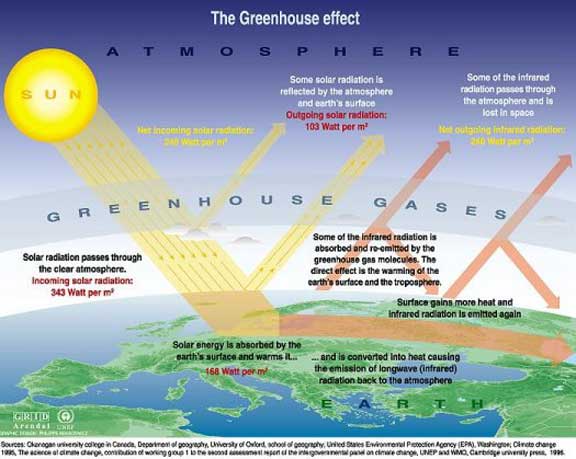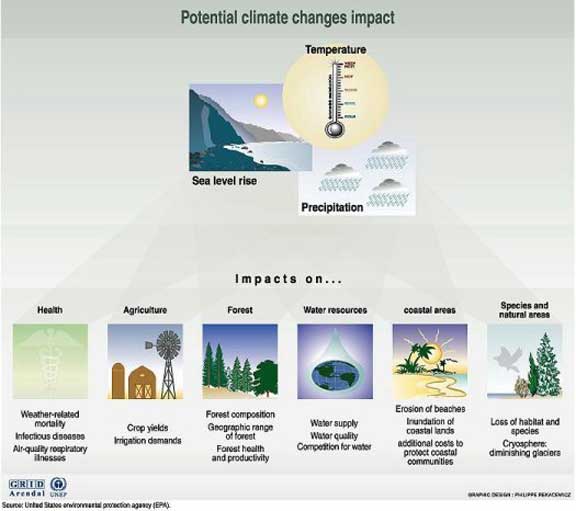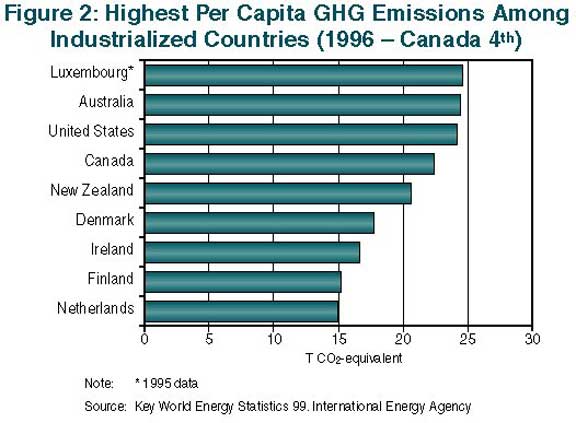|
|
||
|
John Stearman and Frank Ackerman |
||
|
Global Warming And Regulatory Policies: |
||
| Nipawin - Monday, February 25, 2002 - by: Mario deSantis | ||
|
||
|
|
||
|
explanation |
|
|
|
|
Excerpts from: System Dynamics in Action: Global Warming. Section 7.2 of Business
Dynamics, |
|
|
balance |
...The earth is a warm mass surrounded by the cold of space and like such masses emits | |
| so-called black body radiation whose frequency distribution and intensity depends on its | ||
| surface temperature. The warmer the mass. The more energy it radiates. Incoming solar | ||
| energy warms the earth. As it warms, more energy is radiated back into space. The | ||
| temperature rises until the earth is just warm enough for the energy radiated back to | ||
| space to balance the incoming solar energy. | ||
|
atmosphere's |
The amount of energy radiated back into space depends on the composition of the | |
| atmosphere. Greenhouse gases (GHGs) such as carbon dioxide and methane trap some | ||
| of the energy radiated by the earth, instead of allowing it to escape into space. Thus an | ||
| increase in GHGs causes the earth to warm... Natural processes have caused the | ||
| concentration of carbon dioxide (CO2) in the atmosphere to fluctuate significantly over | ||
| geological time, and surface temperatures have fluctuated with it. Human activity has now | ||
| reached a scale where it can affect these [natural] processes... Atmospheric concentrations | ||
| of CO2 and other GHGs including nitrous oxide (N2O), methane (CH4), | ||
| chlorofluorocarbons (CFCs), hydrofluorocarbons (HFCs), perfluorinated carbons | ||
| (PFCs), and others have been growing exponentially, with concentrations of CO2, N2O, | ||
| and CH4 up by 30, 15, and 145%, respectively, since 1800.Mean global surface | ||
| temperatures are about 0.5 to 10C warmer today. By comparison, the mean global | ||
| temperature during the last ice age, when sheets of ice 1000 feet thick covered much of | ||
| the northern hemisphere, was about 50C colder than today... In 1995, the UN sponsored | ||
| Intergovernmental Panel on Climate Change (IPCC) concluded that global warming was | ||
| indeed occurring, and that human activity was responsible, stating "The balance of evidence | ||
| suggests a discernible human influence on climate" (IPCC 1996). Through the UN | ||
| Framework Convention on Climate Change (UNFCCC) various nations are negotiating | ||
| limits to GHG emissions, though compliance remains elusive.. | ||
|
|
||
|
Excerpt from Pricing the Priceless: Cost-Benefit Analysis of Environmental Protection. |
||
|
biased |
In recent years the use of "cost-benefit" analysis to set environmental standards has attracted a large and high-profile group of supporters. According to its advocates, cost-benefit analysis offers a way of achieving superior environmental results at a lower overall cost to society than other available approaches. This view is mistaken. Cost-benefit analysis is a deeply flawed method that repeatedly leads to biased and misleading results... In order to assess the pros and cons of any particular regulatory standard, cost-benefit analysis seeks to translate all relevant considerations into monetary terms... The costs and (particularly) the benefits of regulation often will be realized in the future; in such cases the numeric estimates of costs and benefits are "discounted," i.e. treated as equivalent to smaller amounts of money today. | |
|
life, |
Proponents of cost-benefit analysis make two basic arguments in its favor. First, use of cost-benefit analysis ostensibly leads to more "efficient" allocation of society's resources by better identifying which potential regulatory actions are worth undertaking and in what fashion. Advocates of cost-benefit analysis also contend that this method produces more objective and more transparent government decision-making by making more explicit the assumptions and methods underlying regulatory actions... In fact, cost-benefit analysis is incapable of delivering what it promises. First, cost-benefit analysis cannot produce more efficient decisions because the process of reducing life, health, and the natural world to monetary values is inherently flawed... Cost-benefit analysis also ignores the fact that citizens are concerned about risks to their families and others as well as themselves, ignores the fact that market decisions are generally very different from political decisions, and ignores the incomparability of many different types of risks to human life. The kinds of problems which arise in attempting to define the value of human life in monetary terms also arise in evaluating the benefits of protecting human health and the environment in general. | |
|
trivialize |
Second, the use of discounting systematically and improperly downgrades the importance of environmental regulation... discounting tends to trivialize long-term environmental risks, minimizing the very real threat our society faces from potential catastrophes and irreversible environmental harms, such as those posed by global warming and nuclear waste. | |
|
ignores |
Third, cost-benefit analysis ignores the question of who suffers as a result of environmental problems and, therefore, threatens to reinforce existing patterns of economic and social inequality... | |
|
objectivity |
Finally, cost-benefit analysis fails to produce the greater objectivity and transparency promised by its proponents... | |
|
encourage |
Real-world examples of cost-benefit analysis demonstrate the strange lengths to which this flawed method can be taken. For example, the consulting group Arthur D. Little, in a study for the Czech Republic, concluded that encouraging smoking among Czech citizens was beneficial to the government because it caused citizens to die earlier and thus reduced government expenditures on pensions, housing, and health care... cost-benefit analysis should be rejected as a tool for evaluating environmentally protective regulation. | |
| References: | ||
| Business Dynamics- New system dynamics text book with CD-ROM models and simulation software, J. Spencer Standish Professor of Management, Director, MIT System Dynamics Group http://web.mit.edu/jsterman/www/BusDyn2.html | ||
| Pricing the Priceless: Cost-Benefit Analysis of Environmental Protection. By Lisa Heinzerling and Frank Ackerman, Georgetown Environmental Law and Policy Institute, Georgetown University Law Center, January/February 2002 http://www.globalpolicy.org/socecon/envronmt/2002/CostBen2002.htm | ||
| Sites related to Global Warming: | ||
| Climate Ark - The Premier Climate Change & Renewable Energy Portal http://www.climateark.org/vital/impacts.htm | ||
| International Institute for Sustainable Development http://www.iisd.org/climatechange.htm | ||
| A Primer on Climate Change http://www.ec.gc.ca/climate/primer/sec-6.htm | ||
| Intergovernmental Panel on Climate Change http://www.ipcc.ch/ | ||
| Canada's Greenhouse Gas Emissions http://www.nrcan.gc.ca/communications/cc2000/html/ghg_emissions.html | ||
| United Nations Framework Convention Climate Change http://unfccc.int/issues/index.html | ||
|
|
||
|
Where does Canada Stack up? |
||
|
|
||
|
|
||




